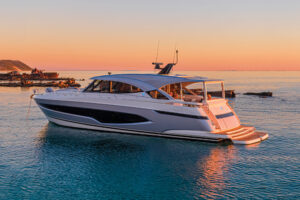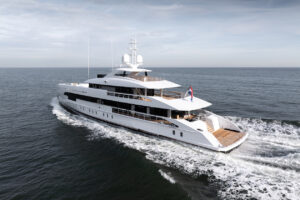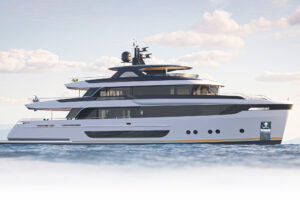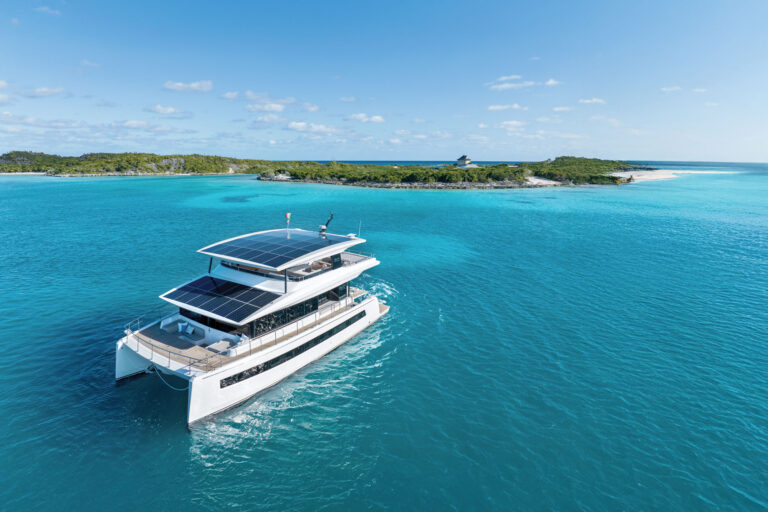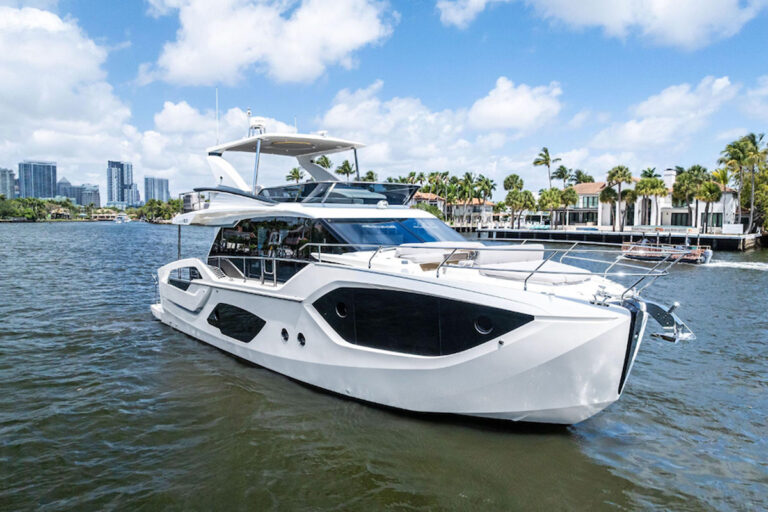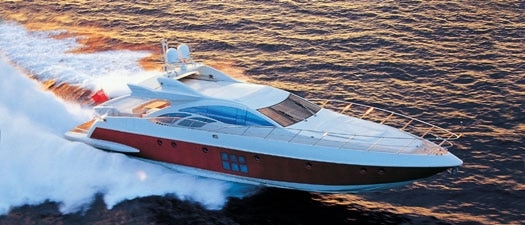
From the swept-back superstructure tot he large aft sunpad and cockpit lounge area, The 86S is a high-performance boat with a differenceItalian style and comfort at a genre-busting level of execution.
The rule of sea trials is you have to take what is on offer. But here was something completely different: not just one new boat, but two-fast motoryachts of the same type fitted with alternative propulsion systems.
The 86S is Azimut’s first venture into the world of high performance. This Italian builder already has a fine reputation for building motoryachts from 39 feet in length upwards, but with the market looking for more speed Azimut decided that it was time to challenge the supremacy of the likes of Pershing and Sunseeker.
Both of the latter offer their designs with Arneson Drives as the propulsion system of choice for high performance. For Azimut, known as a very progressive company in terms of innovation and development, this would be an ideal opportunity to explore water jets-and open up a certain amount of product differentiation.
The possibility to make a direct comparison between different propulsion systems for fast yachts is not something that happens very often. Azimut’s thorough approach to yacht design, however, means that they would make the commitment to build yachts with both of these propulsion systems-so they could not only make the comparison for their own satisfaction, but also be in a position to offer these alternatives to their customers.
Before putting the respective systems to the test, one must do justice to the 86S-a powerful motoryacht with the luxury accommodations that you would expect to find in a yacht of this size. With three staterooms, including a magnificent master that has the large windows in the hull, an Azimut innovation, this yacht offers boating in considerable style. The profile is low and lean, producing a style that speaks of performance. The twin 2,000 hp 16V2000 MTU diesels offer speeds well in excess of 40 knots, certainly high by yachting standards.
Compared with Azimut’s more sedate motoryachts, the ride of this sporting version is rather like the difference between a sports car and a town car. The suspension on the sports version tends to be much firmer, and that is the case here. A certain not-unwelcome harshness in the ride tends to cut in at speeds over 30 knots, giving a greater feeling of performance; although some owners might find it takes a bit getting used to, the experience does deliver the thrill of the high-speed breed.
To explain the ride it is necessary to look at the hull design, a basic deep-V with a deadrise of 13 degrees. Where it differs from conventional deep-V design is by having very pronounced spray rails and chines that have wide flat surfaces. Each one being some 10 inches wide, they generate good lift and allow the hull to plane easily. The trade-off is they also offer a wide flat surface to the waves and the relatively shallow V of the hull does not offer the same cushioning effect that would be found on deeper deadrise hulls.
For styling Azimut used Stefano Righini, their tried and tested designer. The superstructure incorporates the “shark-fin” shape that has become an Azimut signature; above, a huge sunroof slides back into the cockpit shelter to open up the saloon. At the rear of the saloon, a large door opens up to link it with the large cockpit-thus creating one large open space, with a sun bed atop the tender garage and a cockpit array of furniture: a large table, bar and another settee. Everything you need for open-air fun is here.
Below, the master stateroom is a joy with the large side windows and a breakfast nook adding a whole new dimension to gracious living. At speed you can almost see the fish go by and the view could easily distract you from the high level of comfort and facilities-almost, but not really. One or two twin cabins and the VIP stateroom forward complete the luxury picture.
Both below and in the saloon, the emphasis is on light modern design. Fabrics tend to be used in place of wood paneling and there is a strong horizontal element to the design. In the saloon, the designer has used the tables and counters to divide up available space into several parcels; all the required accoutrements are there, including the large plasma TV rising from its base and swiveling to face the seated audience.
The helm station is quite handsome, a brown study in leather and hardwood. The three dedicated leather seats face an array of electronic screens. In addition to the usual radar and electronic chart there is the unique Azimut control and monitoring display plus the two MTU-engine displays. The controls are well placed; in addition to the joystick control on the water-jet version, there are bowthruster and stern-thruster controls on the Arneson version.
Both the Arneson and the water jet keep the engines well aft in a compact layout with the tender garage above. The crew cabins are just forward of the engines and on the standard four-cabin layout the galley is incorporated into these quarters. With the alternative three-cabin version the galley moves forward into the accommodation. In both configurations, communication between the galley below and the dining table above could be easier.
And now we come to the face-off. One version on trial was fitted with Arneson Drives coupled directly to the MTUs while the other was fitted with the engines coupled to Hamilton water jets. There is an increase in weight with the water-jet installation partly because the basic propulsion unit is heavier, but also because the water that is enclosed within the water-jet unit has to count as part of the weight of the boat when it comes to calculating performance. There is also an increase in the price when choosing the water jet version-but then for the extra money you get a joystick control system added in as an extra, and I can assure you that this is an option well worth considering.
First, there are the performance figures to consider. It will not be so easy to make direct comparisons here from the sea trials because the Arneson version of the yacht had marine growth on its bottom and so it was not operating at full efficiency. Azimut claims 46 knots top-speed for this version of the 86S, which is close to what you would expect from a boat of this weight and this power. The boat came onto the plane quickly and easily, and it was fully controllable at high speed-although the ride was quite stiff at speeds over 40 knots.
By comparison, the water-jet version was a revelation in high-performance operation. It planed with the same ease as the Arneson version and it powered up to a top speed of 45 knots, which is close to that of the Arneson version. The main differences were in the acceleration of the jet boat-which added a new dimension to high performance-and in the almost total lack of any vibration due to the turbine-like smoothness of the water jet. The acceleration continued right up to full speed while the Arneson version tapered off after it reached 40 knots.
These aspects alone might not justify the extra cost, but the controllability of the yacht does make a convincing case for using water jets. At speed the response to both the helm and throttle commands was instant-this boat would turn on a dime. Unusual for a water-jet boat, the hull was also directionally stable without any need for fins on the bottom; this was one of the benefits of having the wide chines that increased the grip on the water. There was even the phenomenal braking ability of the water jet that allowed the boat to be stopped in three boat lengths from full speed-but you do need to warn passengers that you are going to do this.
The water-jet version was an exciting boat to drive and this is an important aspect for people buying a high-performance boat. They want some excitement from the performance but it must be safe excitement-and here Azimut does seem to have gained an edge. In addition to the good high-speed aspects of the 86S there is the brilliant low-speed maneuvering from the joystick control.
This can be used at speeds up to around 10 knots and it adds a whole new dimension to yacht control. Just point the lever in the direction you want the boat to travel and the computer works out the right combination of the jet controls to achieve this. Move the lever more in the required direction and the boat goes faster in that direction. Turn the knob on the top of the lever and boat instantly changes its heading in the direction you turn it. It is all so easy and logical. You can park this boat in the tightest of berths once you gain confidence in the system. The only criticism here is that it could be too easy and you can quickly become casual about the whole operation.
With the Arnesons you do have the wonderful rooster tail that does a brilliant job of impressing other boaters. Yet the water jet wins on overall performance and in addition offers you sophisticated control that can be achieved in no other way.
However, there is a downside to the jet installation, apart from the increase in price, and that is the problem of marine growth inside the jet. Leave a jet boat alongside for two or three weeks and you will find that the performance has tailed off dramatically, particularly in warm water. The solution here is simple: Run the jets every few days. That should keep the marine growth at bay.
There is also the problem of owners getting used to a different drive system, but that applies equally to the Arneson Drives. The Arnesons need careful trimming to get optimum performance. In rough seas they do not always operate comfortably at speeds between 15 and 25 knots, when the boat is not fully on plane. It is easy to overload the engines by operating with the drives too deep and you will not get the good throttle response you need at these intermediate speeds for rough-sea operation.
Regardless of which drive you chose, in the 86S Azimut has produced a motoryacht that could become a turning point in fast-yacht design. I am sure that other builders will be watching this design closely; I’m equally sure that there are already owners who are looking carefully at the benefits that water-jet propulsion can offer. For their first move into high performance, Azimut has done well to produce such a magnificent yacht. There are more sports yachts on their way from Azimut and this new kid on the high-speed block could have a considerable impact.
Contact: Azimut Yachts, (011) 39 01193161; www.azimutopen.com; Allied Richard Bertram, (954) 462-5527; www.alliedrichardbertram.com.

